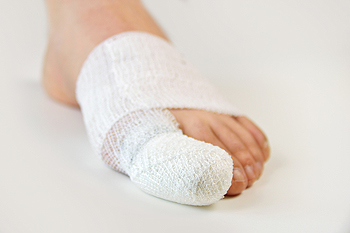Items filtered by date: July 2022
Four Categories of Broken Toes

The bones in the toes are known as phalanges, and the big toe consists of two phalanges. There are four types of broken toes that can occur, compressed, comminuted, displaced and non-displaced. In a comminuted fracture, the bone can break into several fragments. When force presses the ends of the bones towards the center, a compressed fracture has occurred. A bone that is moved out of its normal position is indicative of a displaced fracture, while a broken bone that stays in position is called a non-displaced fracture. The most common toe to break is the pinky toe, and this is often done by jamming it into a piece of furniture, or if something heavy drops on it. If the break is mild, buddy taping may be an effective way to promote stability to the toe as the healing process begins. This is done by taping the affected toe to the toe next to it, which may help keep it straight. If you suspect you have broken your toe, a podiatrist can provide an X-ray that can determine the extent of the fracture, and offer you correct treatment options.
Broken toes may cause a lot of pain and should be treated as soon as possible. If you have any concerns about your feet, contact one of our podiatrists from Foot Care Centers of Palm Beach. Our doctors will treat your foot and ankle needs.
What Is a Broken Toe?
A broken toe occurs when one or more of the toe bones of the foot are broken after an injury. Injuries such as stubbing your toe or dropping a heavy object on it may cause a toe fracture.
Symptoms of a Broken Toe
- Swelling
- Pain (with/without wearing shoes)
- Stiffness
- Nail Injury
Although the injured toe should be monitored daily, it is especially important to have a podiatrist look at your toe if you have severe symptoms. Some of these symptoms include worsening or new pain that is not relieved with medication, sores, redness, or open wounds near the toe.
If you have any questions, please feel free to contact our office located in Boynton Beach, FL . We offer the newest diagnostic and treatment technologies for all your foot care needs.
Reminder: When Was the Last Time...?
How a Podiatrist Diagnoses Athlete’s Foot

Athlete’s Foot is one common and potentially uncomfortable issue that can negatively impact the health of your feet. This condition is essentially a fungal infection that is highly contagious. It is most frequently spread to an individual when they fail to wear shoes in highly-trafficked public areas, such as locker rooms and pool sides. Moisture tends to help this fungal infection thrive and spread quickly. The condition can cause redness, itching, and discomfort. There are several different ways that a podiatrist can go about diagnosing a case of athlete's foot. In some cases, a podiatrist may be able to perform the diagnosis by simply observing the symptoms, such as cracking and discoloration. However, in other cases, a podiatrist may need to perform a skin test to properly diagnose the condition. This is known as a skin lesion potassium hydroxide exam. During such an exam, the podiatrist can take a piece of the infected skin and place it in a chemical called potassium hydroxide. This process ultimately isolates the fungus from the other normal skin cells, allowing the doctor to observe the fungus. If you think that you might have developed a case of athlete’s foot, it may be best to reach out to a podiatrist who can use one of these aforementioned methods of diagnosis.
Athlete’s foot is an inconvenient condition that can be easily reduced with the proper treatment. If you have any concerns about your feet and ankles, contact one of our podiatrists from Foot Care Centers of Palm Beach. Our doctors will treat your foot and ankle needs.
Athlete’s Foot: The Sole Story
Athlete's foot, also known as tinea pedis, can be an extremely contagious foot infection. It is commonly contracted in public changing areas and bathrooms, dormitory style living quarters, around locker rooms and public swimming pools, or anywhere your feet often come into contact with other people.
Solutions to Combat Athlete’s Foot
- Hydrate your feet by using lotion
- Exfoliate
- Buff off nails
- Use of anti-fungal products
- Examine your feet and visit your doctor if any suspicious blisters or cuts develop
Athlete’s foot can cause many irritating symptoms such as dry and flaking skin, itching, and redness. Some more severe symptoms can include bleeding and cracked skin, intense itching and burning, and even pain when walking. In the worst cases, Athlete’s foot can cause blistering as well. Speak to your podiatrist for a better understanding of the different causes of Athlete’s foot, as well as help in determining which treatment options are best for you.
If you have any questions please feel free to contact our office located in Boynton Beach, FL . We offer the newest diagnostic and treatment technologies for all your foot and ankle needs.
Types of Foot Ulcers

Patients who are diabetic may be familiar with wound care for the feet. Elevated blood sugar levels may cause a foot ulcer to gradually develop and immediate treatment may be necessary to avoid further implications, including amputation in severe cases. There are several types of foot ulcers that diabetic patients may experience. Neuropathy can cause a lack of feeling in the foot and patients are unable to feel the pain caused by an injury. A loss of blood flow to the feet can lead to an ischemic ulcer which can be difficult to treat. If the patient has poor circulation and neuropathy, a neuroischemic ulcer may form and it is said to be the most difficult to heal. Approximately half of foot ulcers become infected, therefore they need to be closely monitored. Diabetic foot ulcer treatment begins with removing infected tissue from the wound. This is called debridement and it is crucial in the prevention of damaged nerves, blood vessels, and tendons. This is followed by reducing existing pressure on the foot ulcer and draining the wound. If you have diabetes, it is strongly advised that you are under the care of a podiatrist who can treat and manage diabetic foot problems.
Wound care is an important part in dealing with diabetes. If you have diabetes and a foot wound or would like more information about wound care for diabetics, consult with one of our podiatrists from Foot Care Centers of Palm Beach. Our doctors will assess your condition and provide you with quality foot and ankle treatment.
What Is Wound Care?
Wound care is the practice of taking proper care of a wound. This can range from the smallest to the largest of wounds. While everyone can benefit from proper wound care, it is much more important for diabetics. Diabetics often suffer from poor blood circulation which causes wounds to heal much slower than they would in a non-diabetic.
What Is the Importance of Wound Care?
While it may not seem apparent with small ulcers on the foot, for diabetics, any size ulcer can become infected. Diabetics often also suffer from neuropathy, or nerve loss. This means they might not even feel when they have an ulcer on their foot. If the wound becomes severely infected, amputation may be necessary. Therefore, it is of the upmost importance to properly care for any and all foot wounds.
How to Care for Wounds
The best way to care for foot wounds is to prevent them. For diabetics, this means daily inspections of the feet for any signs of abnormalities or ulcers. It is also recommended to see a podiatrist several times a year for a foot inspection. If you do have an ulcer, run the wound under water to clear dirt from the wound; then apply antibiotic ointment to the wound and cover with a bandage. Bandages should be changed daily and keeping pressure off the wound is smart. It is advised to see a podiatrist, who can keep an eye on it.
If you have any questions, please feel free to contact our office located in Boynton Beach, FL . We offer the newest diagnostic and treatment technologies for all your foot care needs.
Signs of Possible Stress Fractures

Stress fractures of the feet are particularly tricky to recognize. They are hairline cracks in the bones, frequently the long metatarsal bones in the midfoot and the calcaneus bone in the heel. They are considered repetitive injuries and that means the more you repeat an activity, the worse they become. But it can take a while before you even notice the problem. Signs that may help to identify a stress fracture include a deep ache in the foot, a dull pain midway into the activity that fades when you rest, and a pain that just doesn’t go away. Other hints are pain that occurs even when you are not active, pain that worsens at night, and pain that begins about a week after increasing your activity level. Treatment for stress fractures may take weeks or even months. As soon as you recognize that something is wrong, it is a good idea to stop the activity causing the pain and make an appointment with a podiatrist for a full examination.
Activities where too much pressure is put on the feet can cause stress fractures. To learn more, contact one of our podiatrists from Foot Care Centers of Palm Beach. Our doctors can provide the care you need to keep your pain free and on your feet.
Dealing with Stress Fractures of the Foot and Ankle
Stress fractures occur in the foot and ankle when muscles in these areas weaken from too much or too little use. The feet and ankles then lose support when walking or running from the impact of the ground. Since there is no protection, the bones receive the full impact of each step. Stress on the feet can cause cracks to form in the bones, thus creating stress fractures.
What Are Stress Fractures?
Stress fractures occur frequently in individuals whose daily activities cause great impact on the feet and ankles. Stress factors are most common among:
- Runners
- People affected with Osteoporosis
- Tennis or basketball players
- Gymnasts
- High impact workouts
Symptoms
Pain from the fractures occur in the area of the fractures and can be constant or intermittent. It will often cause sharp or dull pain with swelling and tenderness. Engaging in any kind of activity which involves high impact will aggravate pain.
If you have any questions please feel free to contact our office located in Boynton Beach, FL . We offer the newest diagnostic and treatment technologies for all your foot and ankle needs.

